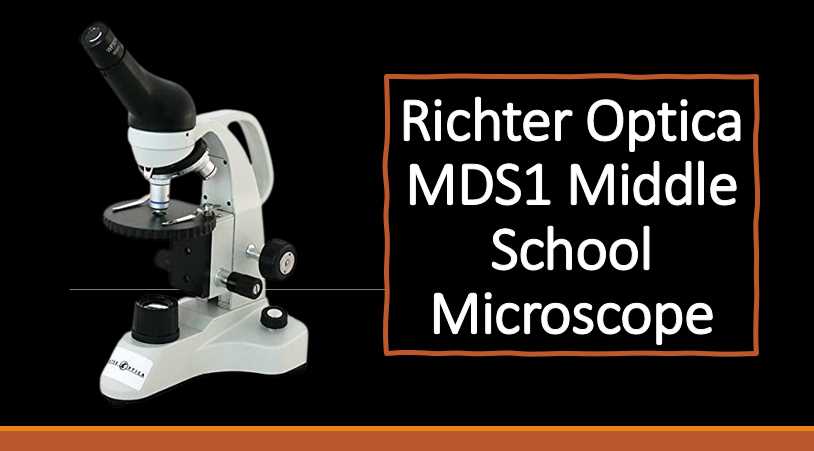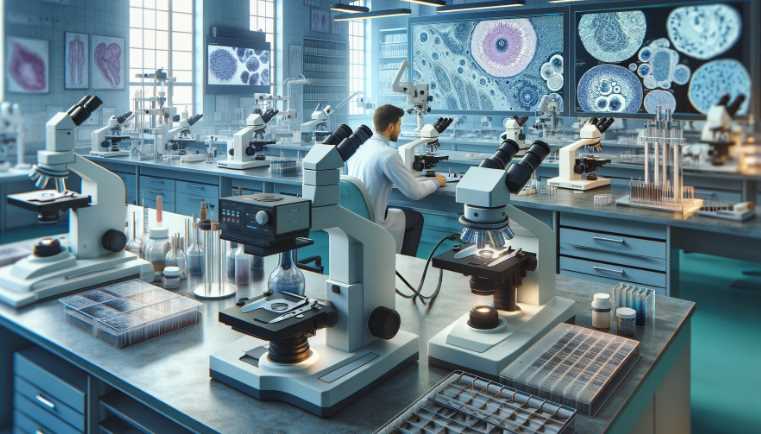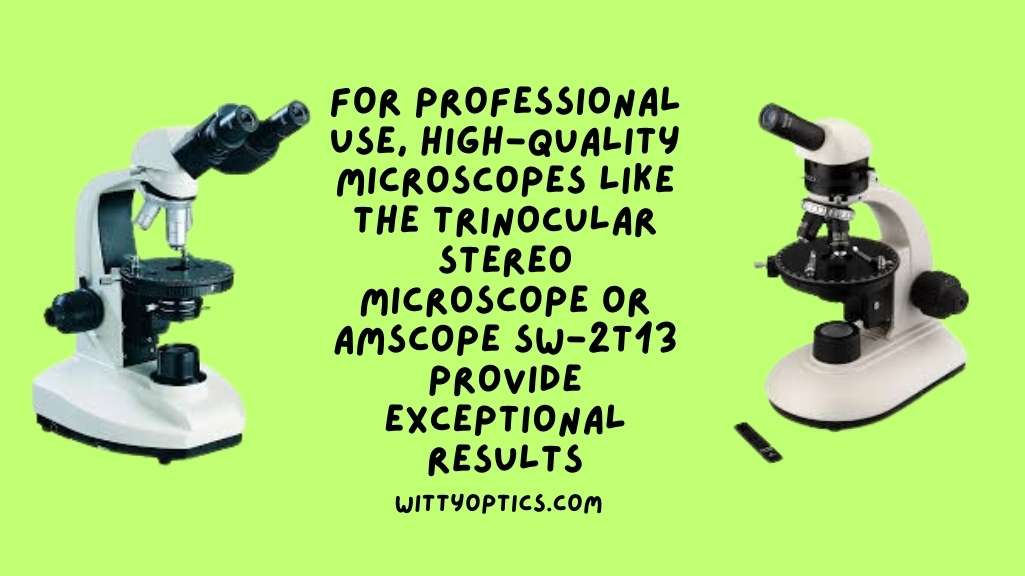The Richter Optica MDS1 Middle School Microscope is an essential tool for exploring the microscopic world and unlocking the secrets of biology, chemistry, and physics. I have learned that the Richter Optica MDS1 is a popular choice for middle school science classrooms. I have come across several instances where teachers and students have used this microscope for their classroom research projects. From examining cells and microorganisms to observing chemical reactions, the Richter Optica MDS1 is a versatile instrument that can help students develop their scientific inquiry skills and enhance their understanding of the natural world.
- Magnification: 40x, 100x, 400x
- Illumination: Cordless and Rechargeable. LED Illumination.
- Focusing: Includes Coarse and Fine Focusing for Crisp, Clear Images
- Construction: Metal frame, glass optics, protective coating on frame. Carrying Handle.
- Stage: Circular stage with locked-on stage clips. Stage slides left-right and forward-backward.

10 Reasons Why the Richter Optica MDS1 is a Great Choice for School Science Classes
The Richter Optica MDS1 middle school microscope is an excellent choice for any science classroom due to its versatile and easy-to-use design, high-quality optics, and durable construction. Here are ten reasons why the Richter Optica MDS1 is a great choice for middle school science classes:
Versatile and Easy to Use:
The Richter Optica MDS1 microscope has a 45-degree inclined head and a rotating head of 360 degrees, making it easy to use from different angles. It also comes with a color-coded turret with 4x, 10x, and 40x (retractable) objectives, allowing different magnifications. Additionally, the microscope has a circular stage that slides forward, backward, and left to right, allowing for observing different specimens.
High-Quality Optics for Clear and Detailed Images:
The Richter Optica MDS1 microscope has a wide-field 10x eyepiece with an FN 16mm pointer that provides a clear and detailed view of the specimens. The microscope’s optics are made of glass, which provides better clarity and color contrast, and its achromatic objectives allow for sharper images.
The Richter Optica MDS1 Middle School Microscope offers a range of magnification levels, including:
| Objective Lens | Magnification Level |
|---|---|
| 4x | 40x |
| 10x | 100x |
| 40x | 400x |
Combine these magnifications with the eyepiece to achieve a maximum magnification of 1600x.
Durable and Reliable:
The Richter Optica MDS1 microscope is constructed with a rugged all-metal frame with an enamel coating that protects it from wear and tear. Additionally, it has a built-in carrying handle, making it easy to move around the classroom. The microscope’s illumination is cordless and rechargeable, which saves money on batteries and ensures that the microscope is always ready to use.
The Richter Optica MDS1 enhances middle school science education in several ways:
Hands-On Learning Opportunities: The Richter Optica MDS1 microscope allows students to observe and study specimens up close, which provides hands-on learning opportunities. Students can explore the micro-world and learn about the different structures and functions of organisms, cells, and tissues.
Development of Scientific Inquiry and Critical Thinking Skills: The Richter Optica MDS1 microscope encourages students to ask questions, make observations, and draw conclusions, which helps them develop scientific inquiry and critical thinking skills. Students learn to analyze data, draw inferences, and develop hypotheses, essential skills for future scientific research.
Preparation for High School and College Science Courses: The Richter Optica MDS1 microscope prepares students for high school and college science courses by providing them with a strong foundation in scientific concepts and laboratory techniques. Students learn how to prepare slides, use microscopes, and conduct experiments, skills they will need in higher-level science courses.
Here are five examples of classroom research projects that can be done using the Richter Optica MDS1 microscope:
Examining Cells and Microorganisms: Students can observe different types of cells and microorganisms under a microscope to learn about their structures and functions. They can also compare and contrast different types of cells and microorganisms to understand their similarities and differences.
Observing Chemical Reactions: Students can observe chemical reactions under the microscope to learn about the different properties of chemicals and the reactions that they undergo. They can also learn about the factors that affect chemical reactions, such as temperature and concentration.
Investigating the Properties of Matter: Students can observe different types of matter under the microscope to learn about their properties, such as density, color, and texture. They can also learn about the different states of matter and how they change under different conditions.
How do I properly clean and maintain the Richter Optica MDS1 Middle School Microscope?
To clean and maintain your Richter Optica MDS1 Middle School Microscope, follow these steps:
| Step | Procedure |
|---|---|
| 1 | Turn off and unplug the microscope. |
| 2 | Use a soft brush or compressed air to remove dust. |
| 3 | Clean lenses with lens paper or a lens cleaning solution. |
| 4 | Wipe down the body with a damp, lint-free cloth. |
| 5 | Check for loose parts or damaged components. |
| 6 | Store the microscope in a dust-free environment. |
Using the Microscope in Conjunction with Other Science Tools:
While the Richter Optica MDS1 microscope is an excellent tool for exploring the microscopic world, it is also important to use it in conjunction with other science tools to provide a more comprehensive understanding of scientific concepts. For example, students can use the microscope to observe and study microorganisms. Still, they can also use other tools such as petri dishes, agar, and microscope slides to perform experiments and investigate the growth and behavior of these organisms.
Similarly, the microscope can be used to observe chemical reactions. Still, students can also use other tools such as test tubes, beakers, and graduated cylinders to perform experiments and investigate the properties of chemicals. Students can develop a more comprehensive understanding of scientific concepts and principles by using the microscope in conjunction with other science tools.
Encouraging Curiosity and Exploration:
One of the Richter Optica MDS1 microscope’s greatest benefits is that it encourages curiosity and exploration. The microscope can ignite curiosity and wonder by providing students with hands-on opportunities to explore the microscopic world, motivating them to ask questions, investigate further, and develop a deeper understanding of scientific concepts.
Teachers can encourage curiosity and exploration by providing students with open-ended projects and assignments that allow them to explore and investigate scientific concepts using the microscope. For example, students can be asked to investigate the properties of different materials, observe the behavior of microorganisms under different conditions, or study the structure and function of cells.
How does the MDS1 microscope compare to other microscopes on the market?
It is easier to comprehensively compare the MDS1 microscope to other microscopes on the market by knowing precisely which microscopes are being compared. However, based on the information provided, here are some potential ways in which the MDS1 microscope could be compared to other microscopes:
- Magnification: The MDS1 microscope has a maximum magnification of 400x, which is relatively low compared to some other microscopes on the market that can achieve magnifications of 1000x or higher. However, it should be noted that high magnification is only sometimes necessary for all types of microscopy.
- Illumination: The MDS1 microscope uses LED illumination, which is a modern and energy-efficient lighting option. Some other microscopes on the market may use different types of lighting, such as halogen bulbs or fluorescent bulbs.
- Focusing: The MDS1 microscope includes both coarse and fine focusing options, which is standard for most microscopes. However, the focusing mechanism’s precision and ease of use may vary between microscopes.
- Construction: The MDS1 microscope is made of metal and has glass optics with a protective coating on the frame. Other microscopes on the market may be made of different materials or have different types of coatings to protect against wear and tear.
- Price: The MDS1 microscope is marketed towards middle school students and is priced accordingly. Other microscopes on the market may be more expensive or geared towards different audiences.
Overall, the MDS1 microscope appears to be a solid choice for middle school students who are learning about microscopy. While it may not have all of the advanced features or high magnification capabilities of some other microscopes on the market, it is a durable and affordable option that can provide clear and crisp images for educational purposes.
What type of lighting does the MDS1 microscope use?
The MDS1 microscope uses LED illumination, which is a modern and energy-efficient lighting option. LED (Light Emitting Diode) illumination provides bright and even lighting, and it does not produce heat like traditional halogen bulbs or incandescent bulbs, which can be a benefit when working with delicate or heat-sensitive samples. LED lighting is also long-lasting and requires minimal maintenance, making it a practical and cost-effective choice for a classroom setting.
What types of samples can you view with the MDS1 microscope?
The MDS1 microscope can be used to view a wide variety of samples, including:
- Microorganisms: The MDS1 microscope can be used to view bacteria, viruses, and other types of microorganisms.
- Cells: With the appropriate staining and preparation techniques, the MDS1 microscope can be used to view plant and animal cells, including those from human tissue samples.
- Tissues: The MDS1 microscope can be used to view thin sections of tissue samples, such as those from plants or animals.
- Insects: The MDS1 microscope can be used to view the detailed structures of insects, including their wings, legs, and other appendages.
- Minerals: The MDS1 microscope can be used to view minerals and crystals, which can be of interest in geology and materials science.
- Pond water: The MDS1 microscope can be used to view the microorganisms and other small creatures found in a pond water sample.
Overall, the MDS1 microscope can be used to view a wide range of samples and can be a useful tool for scientific inquiry and exploration.
How easy is it to switch between magnification levels on the MDS1 microscope?
The MDS1 microscope has three magnification levels: 40x, 100x, and 400x. Switching between these magnification levels is relatively easy and can be accomplished by rotating the objective lens turret, which is located just above the microscope’s stage.
The turret has three positions, each corresponding to a different magnification level, and it can be rotated by hand to switch between them. It is important to note that changing the magnification level may require slightly adjusting the focus using the coarse or fine focus knobs to obtain a clear and sharp image.
Overall, switching between magnification levels on the MDS1 microscope is a simple and straightforward process.
How heavy is the MDS1 microscope?
The MDS1 microscope weighs approximately 3.8 pounds, or 1.7 kilograms. This weight includes the microscope body, objective lenses, and any other attached accessories.
While this may vary slightly depending on the specific configuration of the microscope and any additional accessories, the MDS1 microscope is generally considered to be a lightweight and portable option that is easy to move and transport. The carrying handle on the frame of the microscope also makes it easy to carry the microscope from one location to another, such as between a classroom and a storage closet.
How can the MDS1 microscope be used in the classroom?
The MDS1 microscope is an excellent tool for science classrooms, as it allows students to observe and explore the microscopic world. Here are some ways in which the MDS1 microscope can be used in the classroom:
- Biology: The MDS1 microscope can be used to observe cells, tissues, and other biological specimens, helping students to better understand the structures and functions of living organisms.
- Environmental science: The MDS1 microscope can be used to observe microorganisms in water and soil samples, allowing students to learn about the ecological processes that occur in these environments.
- Chemistry: The MDS1 microscope can be used to observe the properties of crystals and other chemical compounds, helping students to better understand the structure and behavior of matter.
- Earth science: The MDS1 microscope can be used to examine rocks and minerals, allowing students to learn about the composition and history of the Earth.
- Forensic science: The MDS1 microscope can be used to examine fibers, hair, and other trace evidence, helping students to understand the principles of forensic investigation.
Overall, the MDS1 microscope is a versatile and useful tool that can be used in a variety of classroom settings to support scientific inquiry and exploration.
What is the light source type of the Richter Optica MDS1 microscope?

The Richter Optica MDS1 microscope uses an LED light source. This type of lighting provides bright and even illumination, making it easier to view specimens and obtain clear images. LED lighting is also energy-efficient and long-lasting, which means that the MDS1 microscope can be used for extended periods without needing to replace the light source.
Additionally, the cordless and rechargeable design of the LED illumination system makes the MDS1 microscope more portable and convenient to use in various settings. Overall, the LED light source used in the MDS1 microscope is a modern and reliable choice that enhances the overall performance of the microscope.
Is the illumination cordless and rechargeable?
Yes, the illumination on the Richter Optica MDS1 microscope is cordless and rechargeable. This means the microscope can be used without being tethered to a power outlet, allowing for greater flexibility and convenience.
The rechargeable battery provides ample power for extended use of the microscope, and the LED illumination provides bright and even lighting for clear and crisp images. The cordless and rechargeable design of the MDS1 microscope makes it a convenient and practical choice for classrooms, laboratories, and other settings where mobility and versatility are important.
Does the MDS1 microscope provide crisp and clear images?
Yes, the Richter Optica MDS1 microscope is designed to provide crisp and clear images. The microscope uses achromatic objective lenses specially designed to reduce chromatic aberration and produce clear, sharp images with minimal distortion. The microscope also includes coarse and fine focusing knobs, allowing users to adjust the focus precisely and achieve sharp images of the specimen.
Additionally, the LED illumination used in the MDS1 microscope provides bright and even lighting, enhancing the clarity and visibility of the observed specimen. Overall, the combination of high-quality optics, precise focusing, and bright illumination make the MDS1 microscope an excellent choice for obtaining clear and crisp images of microscopic specimens.

I am an enthusiastic student of optics, so I may be biased when I say that optics is one of the most critical fields. It doesn’t matter what type of optics you are talking about – optics for astronomy, medicine, engineering, or pleasure – all types are essential.
Last update on 2025-07-03 / Affiliate links / Images from Amazon Product Advertising API
Table of Contents

